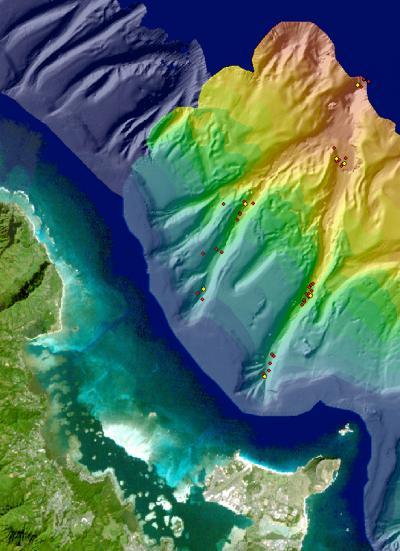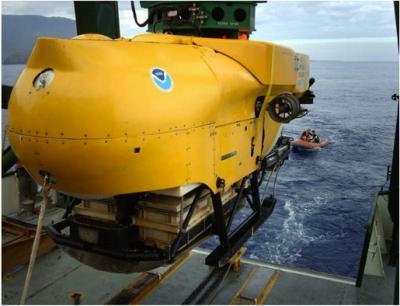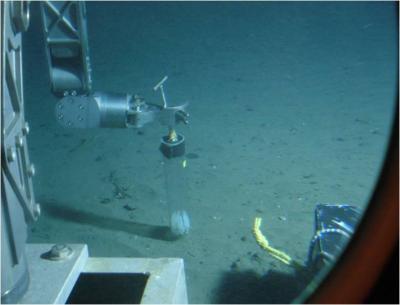Submarine canyons play an important role in maintaining high levels of biodiversity of small invertebrates in the seafloor sediments of the main and northwestern Hawaiian Islands, according to research from the University of Hawai'i at Manoa.
What's more, scientists have used this data to draw new connections between the levels of faunal diversity and the heterogeneity of submarine canyon landscapes at various spatial scales.
"Submarine canyons encompass myriad habitat types," said Fabio C. De Leo, a doctoral graduate from UH Manoa's department of oceanography and the lead author on a new paper that was recently published in the scientific journal Deep Sea Research Part II. "This heterogeneity at the landscape-scale helps to enhance local biodiversity in canyon seafloor sediments."
De Leo and colleagues, including oceanography professor Craig Smith, the study's principal investigator (PI), conducted 34 submersible dives into six underwater canyons and their nearby slopes. Plumbing depths of up to 1,500 meters (~5,000 feet), their study area ranged across the Hawaiian archipelago, from the main Hawaiian Islands through Papahanaumokuakea Marine National Monument in the Northwestern Hawaiian Islands.

UH Manoa researchers sampled diversity in Hawaii's submarine canyons, including these off Kaneohe Bay.
(Photo Credit: University of Hawaii at Manoa)
The scientists evaluated and mapped landscape metrics of each canyon habitat, including the roughness of the seafloor and the steepness of canyon walls. At depths of 350, 650, and 1,000 meters in each location, they collected sediment core samples on the canyon floor. From these samples, they carefully sorted out and identified all of the marine organisms called macrobenthos—including worms, clams and shrimp-like crutaceans— that range in size from a millimeter to several centimeters. The scientists then correlated the macrobenthos species data with the landscape metrics.
The scientists found that submarine canyons can serve as species oases in the sea by channeling ocean currents, capturing and trapping sinking particles, funneling migrating animals, and generally providing a varied physical landscape. As a result, canyons promote high species diversity.
Researchers say this is the first study of its kind to thoroughly examine submarine canyons on island margins. The research effort had previously yielded reports of high species diversity of fish and large invertebrates, the so-called megafauna, in Hawai'i's submarine canyons. This corroboration led them to conclude: "Canyons may be particularly important in the Hawaiian islands, in part because they supply organic matter to the typically food-limited deep sea," De Leo said. "When there's more food, there's more life."

UH Manoa researchers conducted 34 dives into six submarine canyons using the Pisces manned submersibles operated by the Hawaii Undersea Research Laboratory (HURL).
(Photo Credit: University of Hawaii at Manoa)
One thing that became evident from this study was that canyons near the main Hawaiian islands tended to collect and hold much more land-based organic matter than canyons in the Northwestern Hawaiian Islands. Materials such as branches, leaves, nuts and algae were abundant off Moloka'i and O'ahu, washed into the ocean by rain and carried out deep onto the canyon floors by ocean currents. These decomposing materials, scarcer in the islands of Nihoa and Maro Reef, serve as valuable food sources for the seafloor invertebrates, themselves a food source for other, larger fish.
The scientists have already documented four new species discovered during the course of their research dives, including three new types of crustaceans. Up to 60 percent of the species that taxonomists identified in the submarine canyon seafloor samples are only recognized to the family level.
"There is room for discovery of many more new species," De Leo said. "The deep sea fauna of Hawai'i is poorly sampled and poorly understood. Every time we go to sea and sample a new area, it's likely that we'll find a new species."

This is a view of the sediment coring process, from inside the Hawaii Undersea Research Laboratory (HURL) submersible. This picture was taken during a University of Hawaii at Manoa research dive investigating the role that submarine canyons play in maintaining biodiversity of small invertebrates in seafloor sediments.
(Photo Credit: University of Hawaii at Manoa)
Source: University of Hawaii at Manoa